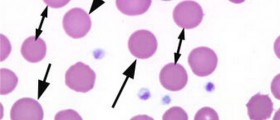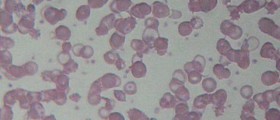 Proteins in the Body: What are globulins?
Proteins in the Body: What are globulins?

The human body in home to many essential proteins, some of which make certain tissues and cells while others are distributed in the bloodstream and other parts of the body, performing their specific duty.
Serum proteins are proteins found in the blood.
There are several classes of serum proteins including albumin, alpha-1 globulins, alpha-2 globulins, beta globulins and gamma globulins.
Globulins are antibodies that may also act as enzymes or function as carriers.
Protein electrophoresis determines the globulin profile and it is responsible for the separation of proteins on charge and size. Globulins are divided into four groups. There are:
- Gamma globulins
- Beta globulins
- Alpha-1 globulins
- Alpha-2 globulins
The immune system is responsible for the secretion of one part of these proteins, while the liver is responsible for the other. Immunoglobulins are very important components of the immune system. Abnormally low levels of globulins usually suggests a deficiency of antibodies due to the biggest portion of the globulins in the gamma fraction.
Normal globulin levels can range from 2.3 to 2.8 g/dl. However, it is also essential to estimate the ratio of albumin to globulin when there are certain abnormalities. This level should be over the 1.0.
Underlying Causes of Low Globulin Levels in Body
Low globulin levels can be caused by many different diseases, and kidney disease is one underlying cause. The level of protein found in the urine may even be negligible. This occurs when the glomerulus, or formation of urine, prevents proteins, blood cells, and other larger structures from passing. The glomerulus structure can be destroyed if a kidney infection is present. This will eventually cause proteins to get in the urine flow. The condition called hypoglobulinemia is associated with the loss of proteins trough urine.
Liver disease can be detected via low globulin count. Bilirubin levels can be increased if jaundice — a yellowing of the skin and eyes often seen in liver disease — is present.
Marasmus and other malnutrition-related diseases can cause low level of globulin as well, along with gastrointrestinal conditions such as inflammatory bowel disease and Celiac disease.
There are many symptoms associated with low level of globulin levels and this makes diagnosing it relatively easy, since physicians will know to run the appropriate tests. The most common symptoms of low globulin levels are increased susceptibility to infectious diseases and edema (swelling caused by fluid buildup) located on the body's limbs. Fatigue is also common. See a doctor if you have any of these symptoms, as you could have abnormally low levels of globulin. Your doctor will do a simple blood test and see if this problem is really troubling you.
High Levels of Hemoglobin
Hemoglobin is a metalloprotein that serves the purpose of oxygen transport, and it is a major part of red blood cells. The main role of hemoglobin in the human body is to carry oxygen from the lungs to the rest of the body, and collect carbon dioxide to bring it back to the lungs.
The iron in hemoglobin is what gives erythrocytes their characteristic red color, and in turn what makes the blood red. Another significant role of hemoglobin is to maintain the shape of the red blood cells. An anomalous hemoglobin structure may interfere with the normal shape of red blood cells and this way affects their function.
Hemoglobin is one of many components of human blood that are measured as a part of a complete blood count test, an integral part of an overall health evaluation. The level of hemoglobin determines the severity of anemia or polycythemia, monitors the response to treatment and helps to diagnose other health problems.
Blood which is going to be tested is obtained from a vein with the assistance of a needle. It is collected in an airtight vial or tube. This vial or tube is easily attached to the needle and allows the direct taking of blood samples.
Hemoglobin is measured as the amount of metalloprotein in grams (g) per deciliter of whole blood. Each and every lab has its own optimal range of hemoglobin which does not vary a lot and the age as well as the gender of the patient being tested determines the proper amount of this protein.
What is Behind High Levels of Hemoglobin?
A high hemoglobin count is an indicator of certain imbalances, or it may be associated with adaptive mechanisms. Increased levels of hemoglobin does not necessary mean that the number of erythrocytes is also high. Different cells may have different amount of hemoglobin proteins, and a high hemoglobin count is often possible, even if the blood cell count falls within the normal range.
In most cases, a high hemoglobin count is caused by exposure to high altitudes. High hemoglobin counts also frequently affect smokers and is closely related to dehydration and certain malignant diseases. In the majority of cases, dehydration plays some role in causing high hemoglobin levels.
Sometimes dehydration is the only cause. In this case, once the patient's intake of fluids improves, the hemoglobin results soon return to normal.
High hemoglobin levels are normal for all people living at high altitudes. Namely, at high altitudes the air is not rich enough in oxygen as it is at sea level. As a result, a person inhales less oxygen compared to people living at sea or near sea level. The body tries to compensate by producing more erythrocytes able to carry more oxygen to all the body cells, which also results in higher amount of hemoglobin.
Lung diseases may also affect a person's hemoglobin count as the red blood cell production increases to compensate for the low blood oxygen levels seen in these medical conditions. The results are also elevated if the kidneys release too much protein that enhances the red blood cell production, or if a patient has a bone marrow dysfunction that results in an increased production of red blood cells.
















Your thoughts on this
Loading...